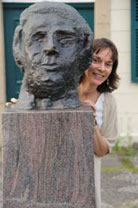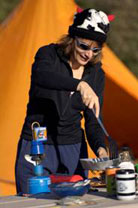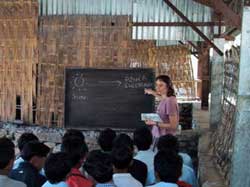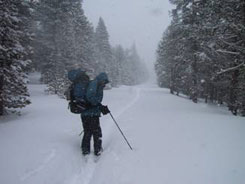Nicola Spaldin
 On a "pilgrimage" to the Schumann House in Bonn. Photo courtesy of Prof. Nicola Spaldin
On a "pilgrimage" to the Schumann House in Bonn. Photo courtesy of Prof. Nicola Spaldin 
Camping in Joshua Tree National Park. Photo courtesy of Prof. Nicola Spaldin
After graduating in 1991, Spaldin became a PhD candidate in chemistry at the University of California - Berkeley. When Prof. Spaldin was asked how she became a physicist after having most of her academic background in chemistry, she replied, "I kind of drifted into it. Looking back, I was always heading towards materials physics, I just didn't know that what I was doing was called that." As she pursued her PhD in chemistry she studied materials at the atomic and molecular level, working with semiconductors and magnetic materials. When she began to search for a postdoctoral program, she found a match for her interests in materials physics in Prof. Karin Rabe's group in the Applied Physics department at Yale University. When asked about changing from a PhD in chemistry to postdoctoral work in Applied Physics, she said, "it wasn't really a change; I moved from the solid-state physics end of chemistry to the materials chemistry end of physics!"
Professor Spaldin has always had many jobs and interests: researcher, writer, teacher, data collector and administrator at work; mountain climber, skier and clarinetist in her free time. When asked how her outside interests influence her physics she said "Maybe that's why I like to do multidisciplinary research. I enjoy interacting with diverse groups of people: physicists and chemists, or musicians and mountaineers! I've also learned a tremendous amount about how to teach effectively in my "outside" life — for example, musicians have quite a different perspective on student learning than we usually have in the sciences." She recommends that anyone who is interested in physics, "get into the lab. Get out of the classroom and find a project in the lab. There is no substitute for doing physics."
Like her varied background, Prof. Spaldin spends her time researching how to get materials to do multiple tasks. She uses calculations and simulations to design materials that combine more than one function. "Basic laws say this property can't coexist with this property and we try to get around that," she said. For example, "In your laptop, a semiconductor material processes the information and a magnetic material stores the information. If we could process and store in the same piece of stuff, we could make your computer smaller, lighter and able to use less power." Her research continues to have real implications in technology as iPods shrink and PCs become the size of notepads. But more importantly, Prof. Spaldin was able to discover her passion, something that she lives her life by. She says, "Do what you're passionate about. If you're passionate about physics, do it. It may not be the easiest choice, but it will be the most rewarding."
 Teaching English in the Kangchenjunga valley in Nepal Photo courtesy of Prof. Nicola Spaldin |
 Skiing across the Sierras in blizzard Photo courtesy of Prof. Nicola Spaldin |
Prof. Spaldin is about to move from UC Santa Barbara to ETH Zürich where she will be Chair of Materials Theory in the Department of Materials. "It's time for new adventures!" she says.











